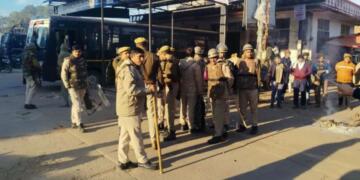The island city of Mumbai has been rocked by the protests against the proposed Metro-3 car shed at Aarey. The Supreme Court had given a green light to the proposed felling of 2,700 trees as the benefits of the project far outweighed the cost of cutting down the trees. Despite the SC order, there were widespread protests and misinformation campaign as yet again so-called environmentalists and activists joined hands to stonewall the country’s development and unsuspecting people unknowingly fell prey to their nefarious agenda.
As expected, media and eyeballs hungry Bollywood stars didn’t want to be left behind and some of them joined the protests and took to social media to preach. Ironically, the same Bollywood celebrities they have no qualms when shooting in Film City which is built inside the heart of Aarey, thus exposing the hypocrisy of the Aarey protestors.
To say Mumbai’s infrastructure is crumbling is an understatement as the city desperately needs infrastructure projects to decongest itself. Across the globe, climate change is being used as a weapon to destabilise governments and run massive misinformation campaigns against the government and the Aarey protests are part of a larger scheme of things.
The protests are staged and co-ordinated which was quite evident when Bollywood actor Dia Mirza and Manoj Bajpayee posted identical tweets just a couple of minutes apart as they lent their support to the protests. Irony died a thousand deaths that day as people who refuse to travel anywhere without their luxury cars sought to label others as being ‘anti-environment’ whose everyday travel involves travelling in dangerously packed local trains and BEST buses. Other Bollywood hypocrites like Twinkle Khanna, Shraddha Kapoor, Richa Chaddha, Varun Dhavan, Farhan Akhtar and others too opposed the felling of trees for the crucial metro car shed, an alternative for which was not available to Mumbai Metro Rail Department.
People who live/work in the blue circle are saying that construction of Metro shed in red circle is bad for the environment and wildlife. pic.twitter.com/JgC5h1mZwc
— Spaminder Bharti (@attomeybharti) September 19, 2019
While the activists and Bollywood actors might want us to believe that Film City was built from thin air, the fact is that the construction of Film City caused widespread ecological damage. The Film City, officially called the Dadasaheb Phalke Chitranagari, is an integrated studio complex having around 42 outdoor shooting locations and has a sprawling campus spread across a whopping 210 hectares of Aarey land. The Aarey Colony currently occupies 1300 hectares and the government has marked 25 hectares of Aarey land which will be used for the metro car depot, which amounts to out 2% of the entire area of the Aarey Colony.
Film City continues to thrive inside Aarey and unsurprisingly, there were no protests when Film City was proposed in Aarey, and there is no boycott of the complex that caused the felling of 10 times more trees than the metro car shed built for public welfare.
In fact, the 520-acre Film City is all set to undergo a makeover, worth Rs 2,600 crore, which includes setting more indoor studios and outdoor locations, a museum, theme parks, better post-production facilities, food courts, hotels and an amphitheatre, among other things. One doesn’t need to be an environmentalist to know that the makeover will be at the cost of the Aarey ecology and the same activists and Dia Mirza’s of the world will have no qualms when the trees are felled for the makeover of Film City.
One of the major points of the protests by the activists is the fact that man-animal conflict will increase if the car shed is allowed to come up owing to its proximity to the Sanjay Gandhi National Park. However, the metro depot is well outside the buffer limit and the man-animal conflict angle is pure fiction. Earlier this year, leopard and deer carcasses were found in Film City near a TV show set and this incident brought to light how the area had become a poaching den with 30 active wire snares (equipment to trap wild animals) across various remote zones. The resultant food waste from the shoots of films and TV shows attracts animals to the Film City campus, putting them in harm’s way, but there were no protests against it and there will never be.
While the Bombay High Court junked all the petitions and in a rare case also fined the one of the petitioners a sum of Rs 50,000 for frivolous petitioning.
One of the petitioners Biju Augustine was found to live in Royal Palms which covers about 240 acres deep inside Aarey, abutting the National Park and recently Royal Palms built a 422 room hotel next to Sanjay Gandhi National Park which was inaugurated by none other than the then Congress CM Ashok Chavan.
Royal Palms in another massive complex that slaughtered thousands of trees in an area of 240 acres or 97 hectares. It is a mixed-use campus housed in the lap of the green belt of Mumbai’s Aarey Milk Colony with commercial spaces, residential properties, malls and hotels. Royal Palms has three hotels inside the heart of Aarey colony consisting of The Palms Hotel – a 245 room hotel which was built in 2005, the Palms Villa Hotel, a hotel which consists of 109 individual villas of 1,200 square feet each with a sundeck, living room, bedroom and a swimming pool and the third property being sold is the 422 room hotel called the Imperial Palace which was built in 2009. The construction of these hotels faced no hiccups as it didn’t fit in the agenda of the so-called environmentalists and activists.
The Hiranandani complex spread across 240 acres at the Powai SEZ is another product of the slaughter of thousands of trees is also far more damaging to the ecology. But for the elite, it is all alright, for their lavish excesses are a fundamental right, while the common man asking for a better transport facilities is selfish.
The hypocrisy of the activists when it comes to Film City, Royal Palms Colony and several other areas, further proves the fact that they have manufactured the protests to destabilise India and ensure that India’s development projects never take off with the Kudankulam and Sterlite plant prime examples of how the protests are fabricated to stonewall India’s rapid pace of development. Much has been written about the alternative routes proposed by the activists which are not only logistical feasible but the costs associated with the alternate routes will ensure that Mumbai Metro will never be a successful project and will continue to bleed money for years to come.
About 13,000 objections were received for the project and out of those 13,000, 10,000 objections were from one Bengaluru-based website indicating suspicious, coordinated activity sponsored by larger players, which special in the stalling of the metro project.
The project has received funding from Japan who in turn, did a study on the project for one year with sustainability in mind and after that, they gave funding to it. Total tress affected for car depot is 2700 of which CO2 absorption capacity would be 80 to 90 Ton per year. Metro 3 once commissioned would reduce 2.25 lakh ton CO2 and other oxides of Carbon and Nitrogen per year. This estimation is done by independent auditors of UNFCC.
For someone like me whose daily commute involves catching a Churchgate train from Andheri station in the morning and returning in the evening by a Virar local, there are clear indications that the cost of human lives is negligible, especially for the elite. I am a first-hand witness every day to the overcrowded Andheri station which hosts about 7,00,000 commuters every day, and the conditions for such travel are in no way normal.
There is a desperate need to decongest the suburban locals as even the smallest of malfunction can lead to a major tragedy and the same activists will once again come out to slam the government for the poor infrastructure of Mumbai. Bollywood actors like Shraddha Kapoor, Farhan Akhtar and Dia Mirza or the well-paid activists will never understand the pain of travelling every day in packed locals and I am sure if they are made to travel by locals for just one week, they would themselves lay the foundation of the metro car shed. Every day, 10 persons die due to overcrowding in local suburban trains and the Metro project will ease the pressure from the trains and if the authorities pay heed to such obstructionist activists, India’s middle class will have to travel in bullock carts while the actors and activists continue to travel in their luxury cars.






























